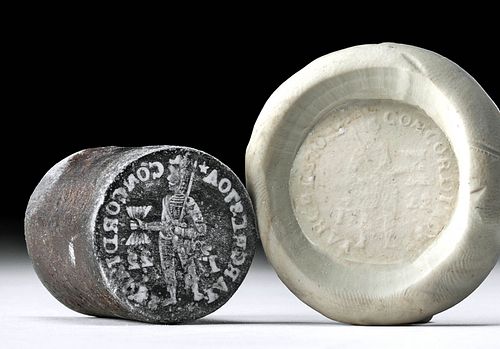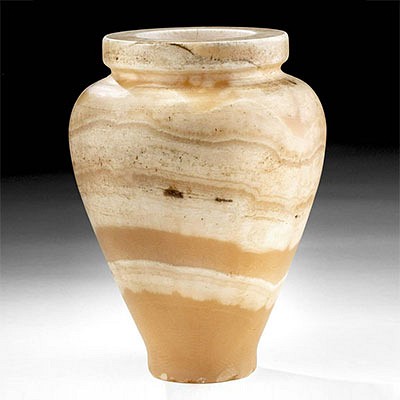Rare 1722 Dutch Iron Coin Die (for Ducat)
Lot 47
About Seller
Artemis Gallery
686 S Taylor Ave, Ste 106
Louisville, CO 80027
United States
Selling antiquities, ancient and ethnographic art online since 1993, Artemis Gallery specializes in Classical Antiquities (Egyptian, Greek, Roman, Near Eastern), Asian, Pre-Columbian, African / Tribal / Oceanographic art. Our extensive inventory includes pottery, stone, metal, wood, glass and textil...Read more
Estimate:
$1,800 - $2,500
Absentee vs Live bid
Two ways to bid:
- Leave a max absentee bid and the platform will bid on your behalf up to your maximum bid during the live auction.
- Bid live during the auction and your bids will be submitted real-time to the auctioneer.
Bid Increments
| Price | Bid Increment |
|---|---|
| $0 | $25 |
| $300 | $50 |
| $1,000 | $100 |
| $2,000 | $250 |
| $5,000 | $500 |
| $10,000 | $1,000 |
| $20,000 | $2,500 |
| $50,000 | $5,000 |
| $100,000 | $10,000 |
| $200,000 | $20,000 |
About Auction
By Artemis Gallery
Dec 17, 2020
Set Reminder
2020-12-17 10:00:00
2020-12-17 10:00:00
America/New_York
Bidsquare
Bidsquare : VARIETY SALE | Antiquities & Ethnographic Art
https://www.bidsquare.com/auctions/artemis-gallery/variety-sale-antiquities-ethnographic-art-6207
Featuring classical antiquities, ancient and ethnographic art from cultures encompassing the globe. Egyptian, Greek, Roman, Etruscan, Near Eastern, Asian, Pre-Columbian, Native American, African / Tribal, Oceanic, Spanish Colonial, Russian, Fossils, Fine Art, more! Artemis Gallery info@artemisgallery.com
Featuring classical antiquities, ancient and ethnographic art from cultures encompassing the globe. Egyptian, Greek, Roman, Etruscan, Near Eastern, Asian, Pre-Columbian, Native American, African / Tribal, Oceanic, Spanish Colonial, Russian, Fossils, Fine Art, more! Artemis Gallery info@artemisgallery.com
- Lot Description
Europe, Dutch Republic, 1722. A rare and intriguing iron coin die with a cylindrical body and circular base used to stamp the obverse side of a ducat in the Dutch Republic of 1722. Though the stamp is of course backwards, one can see from the impression that it features - a rightward facing knight in a helmet standing with one foot forward as he leans back, holding out a handful of arrows in his left hand and a long sword in his right. The fully armored and mustachioed gentleman stands between the numbers '17' and '22', indicating the year, and is encircled by the inscription "Concordia Res Parva Crescunt", which is Latin for "Union makes small things grow"; a quote that resonated deeply with the small state of the Dutch Republic who had recently acquired vast amounts of territory in Asia and the Americas. Size: 0.875" dimeter x 1.0625" H (2.2 cm x 2.7 cm)
During the 15th century, as Europe and its traders/colonizers/missionaries spread throughout the world, merchants began to shift their business currency from the florin to the ducat. Ducats served as the model for other currencies throughout Europe during the coinage reforms of the 16th, 17th, and, in the case of England, the early 18th centuries, as European rulers standardized their coinage. They were ultimate superseded by the Spanish dollar as the dominant currency of world trade due to the raw bullion the Spanish were extracting from mines in their New World colonies, but their supremacy at a crucial time in European coinage history ensured their place in history.
Provenance: ex Estate of Eldert Bontekoe, Pegasi Numismatics, Ann Arbor, Michigan USA acquired before 2000
All items legal to buy/sell under U.S. Statute covering cultural patrimony Code 2600, CHAPTER 14, and are guaranteed to be as described or your money back.
A Certificate of Authenticity will accompany all winning bids.
We ship worldwide and handle all shipping in-house for your convenience.
#158469Expected nicks, chips, and abrasions to body and stamp. Light softening of detail on stamp commensurate with age and use. Otherwise intact and excellent.Condition
- Shipping Info
-
All shipping is handled in-house for your convenience. Your invoice from Artemis Gallery will include shipping calculation instructions. If in doubt, please inquire BEFORE bidding for estimated shipping costs for individual items.
-
- Buyer's Premium



 EUR
EUR CAD
CAD AUD
AUD GBP
GBP MXN
MXN HKD
HKD CNY
CNY MYR
MYR SEK
SEK SGD
SGD CHF
CHF THB
THB













